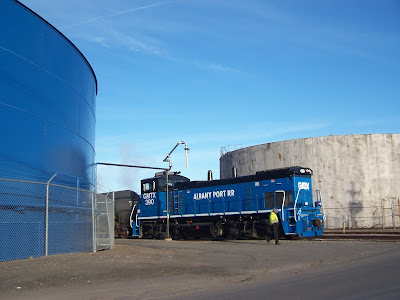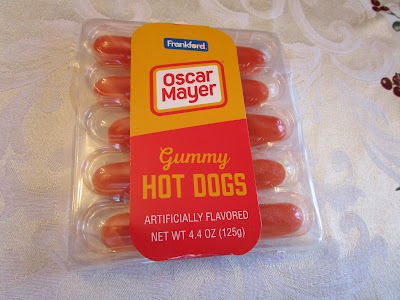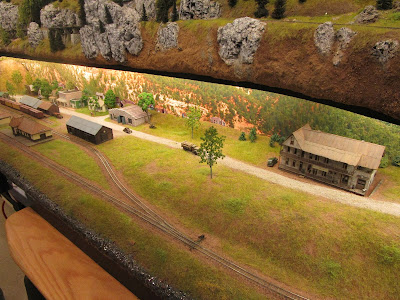This blog will be a record of my personal journey in researching, building, operating, and finally sharing my HO scale layout based on the Delaware and Hudson Railway's "Colonie Main Line."
CP Executive train in Albany

Thursday, June 29, 2023
Railfanning: Albany Port Railroad
Sunday, June 25, 2023
A short D&H train (1989)
Here is a shot of D&H RS36 #5017 pulling a single gondola somewhere is a pastoral scene. Dated June 1989, I know nothing else about it but I can sort of make out ties inside the gondola so perhaps it is on an MOW job.
Wednesday, June 21, 2023
Oscar Mayer Wienermobile transport car (O scale)
I have always been enamored with the Oscar Meyer Wienermobile ever since I was a child. My father would give me various trinkets such as Wienermobile whistles (including some from the SuperBowl and glow in the dark ones), and I have been searching for the real vehicles for years. Hot dogs are my favorite food and I love them, and a giant one that you could drive around in seemed neat. So, this project was inevitable. However, it has had a tortured timeline:
Note: regardless of what Oscar Meyer calls it now, it will always be the "Wienermobile."
Summer 2020
I was driving on the Thruway near Schenectady, NY and I saw the Oscar Mayer Wienermobile approaching on the other side of the highway. I was pretty excited, but I didn't have a smart phone to take a picture and even if I tried I doubt I could have done so safely. So, I went to the Oscar Mayer website and discovered that there was a Wienermobile tracker. With that online resource, I hoped to find see it again in the future and take pictures of it but I soon forgot about it.
Spring 2021
At a train show many months later I found an old Wienermobile bank that was roughly O scale and thought it would make a neat flat car load. The bank was in bad shape but it was cheap ($15) so I bought it. Parts of it were broken and faded and I hoped to repair and repaint it. In the process of looking for replacement decals for the letting on Ebay, I found a newer version in excellent condition for the same price ($15) including delivery. I bought it, and set the old one aside never to return to it. Interestingly enough, as can be seen on the picture below the windows and chassis are different molds. Then, I searched for an inexpensive O gauge scale flat car to mount it onto and soon forgot about it.
Early November 2022
Fast forward more than a year and my parents visited us in November. During their stay I happened to relate the Wienermobile sighting story to my Dad. He had given me several Wienermobile whistles and different times in my childhood and they were special to me. So, we chatted about it some more and I decided to get to work on it. Then, I promptly forgot about it.
Veterans Day, November 11, 2022
Literally five days after my parents left, my wife found on Facebook that the Wienermobile was coming to Albany the upcoming weekend for six different events! (What are the odds?)
As luck would have it, one of them fit into our busy schedule so we drove up to an elementary school on Veterans' Day where it was to be displayed at the start of a fundraiser race. We waited and waited, and wondered if maybe we were in the wrong place. But then it came into view and I got giddy. As it turns out, it had to stop right next to our car in the parking lot to get further instructions from the event coordinator so we took that chance to jump out and take lots of pictures! Note the smaller Wienermobile on the front dashboard!
We couldn't wait around to see if they had special things going on involving the vehicle as we had other plans for the day, but we did have time for one more picture. Someday Harrison will think this shot is really cool or roll his eyes. Perhaps both.
With the fire burning, I decided to find a suitable flatcar for my model. The trick is that it had to be both a "scale" car (no toy-like semi-scale or toy proportioned business) and the deck had to be at least 2.5" wide to match the width of the model Wienermobile's wheels. I asked on an online forum about suitable flatcars and several options popped up. Unfortunately, most flat cars are sold with loads (tanks, trucks, crates) and I didn't want to pay for any of that stuff. So, I looked and waited for a good deal, and promptly forgot about it.
January 2023
After several unsuccessful train shows I found a guy online willing to sell me a custom-modified K-line 50' flatcar. He had added a real wood deck and side boards and painted it for the Rutland Railroad. It should have been perfect for my project, but on arrival I discovered that the deck wasn't wide enough and the Wienermobile's wheels kept falling off the side. Instead of removing his custom deck to add a wider one, I set the project on hold again and moved on to other things. And promptly forgot about it.
June 2023
A friend took pity on my plight and bought me a Lionel scale 50' flatcar as as gift. It isn't as detailed as some of the newer releases but it was a lot more affordable and certainly would be perfect for my project. More importantly, he had made sure that the deck was 2.5" wide. And, it was something that I now actually had in hand (so I could get working on the project again). Perfect!
The flatcar was painted dark brown for the AT&SF and that included the molded wooden deck. I considered staining and gluing down individual boards but as the deck was in great shape with lots of bolt detail I decided to see what would happen if I painted it. So, I unclipped the plastic deck assembly from the bent steel frame and masked the deck boards area. Then, I sprayed it with flat tan paint. If I didn't like how it turned out, I could always go back and add the individual boards.
But, the transformation was so striking that I decided to leave it. It now looked like wood and would be a good starting point for weathering the molded boards.
I applied several diluted acrylic paint washes onto random boards on the deck. I wasn't going for perfection, and since the finished model won't be super-realistic anyway I was okay with a more generic weathering approach.
By the end, my paint/water cup was pretty gross looking, which was perfect for a wash on the sides of the car. This reminded my why I hate using water to dillute acrylic paints... if you don't get perfect coverage, you get splotches. And, you need to use distelled water or risk white mineral deposits showing up. I much prefer oil paint washes but was too lazy to set them up. I finished up with some orangy rust drybrushed on the edges, and some light gray drybrushed on the deck boards. I was happy with the results.
The frame and chassis were also drybrushed with acrylic paints to weather them. The wheels were treated with rusty brown colors, as were the couplers. The underside focused more on dirt colors even though it really isn't visibile under most conditions. Some dustying of brighter orange highlights accentuated the raised details.
I didn't want to glue the Wienermobile on in case Harrison wanted to play with it. But, I also couldn't have it falling off. So, I needed some wooden chocks on the deck (no chains as they would be too permanent). I pulled out some square stripwood from my inventory and cut and stained it with my alcohol ink solutions. I focused mainly on brown washes to compliment the colors of the deck.
Four large pieces of wood run parallel to the sides and are installed directly inside of the wheels. They prevent the Wienermobile from shifting side to side... and falling off the flatcar! Because they served an an important purpose I used oversize wood. Besides, at the end of the day this is going to be a toy and not a scale model. Once thing I noticed after they were glued down is that the rear wheels are spaced differently on the axles than the front wheels. So, I had to shim out the blocks on the rear axle. Then, small angluar bits were cut using my miniature miter box and glued on. On Father's Day morning, I finished the project.
Finally, it was ready to hit the road. Even though the bank itself is really light the overall model is a little top heavy, and running through tight 0-27 curves at speed would likely lead to a disaster. Thankfully, sourcing another Wienermobile would not be tough if this one were to get damaged.
Now, to celebrate with some gummy hot dogs...
Saturday, June 17, 2023
A Tribute to Bob Hamm, M.M.R.


Out of the group of 6-8 people who took him up on his offer I was the only one working on rolling stock, a D&H bobber caboose which later became my first piece of rolling stock to earn a merit award. Bob gave me lots of insight into what I should and should not be doing to not only maximize judging points (my immediate goal) but also improve my modeling skills as a whole (my long term goal). Through inspiration and/or fear he taught me how to strive for my absolute best, whether it was scratchbuilding windows instead of using castings; cutting and applying 3,618 individual cedar shingles on a roof; adding interior and exterior details to structures that most people would never even notice; or researching prototype pictures to justify decisions instead of just guessing.
When my models didn’t live up to the requirements necessary for a Merit award he would kindly point out areas to improve on. And we had a lot of laughs too, such as when I randomly picked a Sinclair gas station to model and it turns out his father used to own one! Yeah, that model received a lot of scrutiny during judging.
A modeler must certify when they submit their MMR paperwork that they will agree to assist other members in this subject whenever possible. Bob certainly met that requirement, and for his help I am tremendously thankful. He may be an excellent modeler, but he is also a fantastic teacher. His legacy will live on in. And, my last structure which was a wooden engine house protects a steam engine lettered for the Hamm Surman Lumber Company in his honor.
The below picture is the exterior wall of a bathroom in his basement. He decorated it to look like a station house!
This winter I decided to start a new column in the Hudson Berkshire Division's Form 19 newsletter called "Derailed" where members could share anecdotes of failed modeling projects. I asked all of the readers to submit stories but specifically quipped (only partially joking) that Bob probably had never made a mistake in his life and wouldn't have anything to share. He thought it was funny...
And then, when I recently visited him, he presented me with the model below. It looks like a nice passenger car, and it is... it earned him a merit award in 1972. When I asked why he was giving it to me he confided that it contained a mistake. When he explained what it was I could only roll my eyes... it was something no one would consider a "mistake" except him. But now it is a secret that we both share, and I will treasure the model.
I will truly miss him, but his wisdom will live on through my own models. He was the best teacher I could have asked for.


.jpg)



























%20RS36%20%235017.JPG)


















































